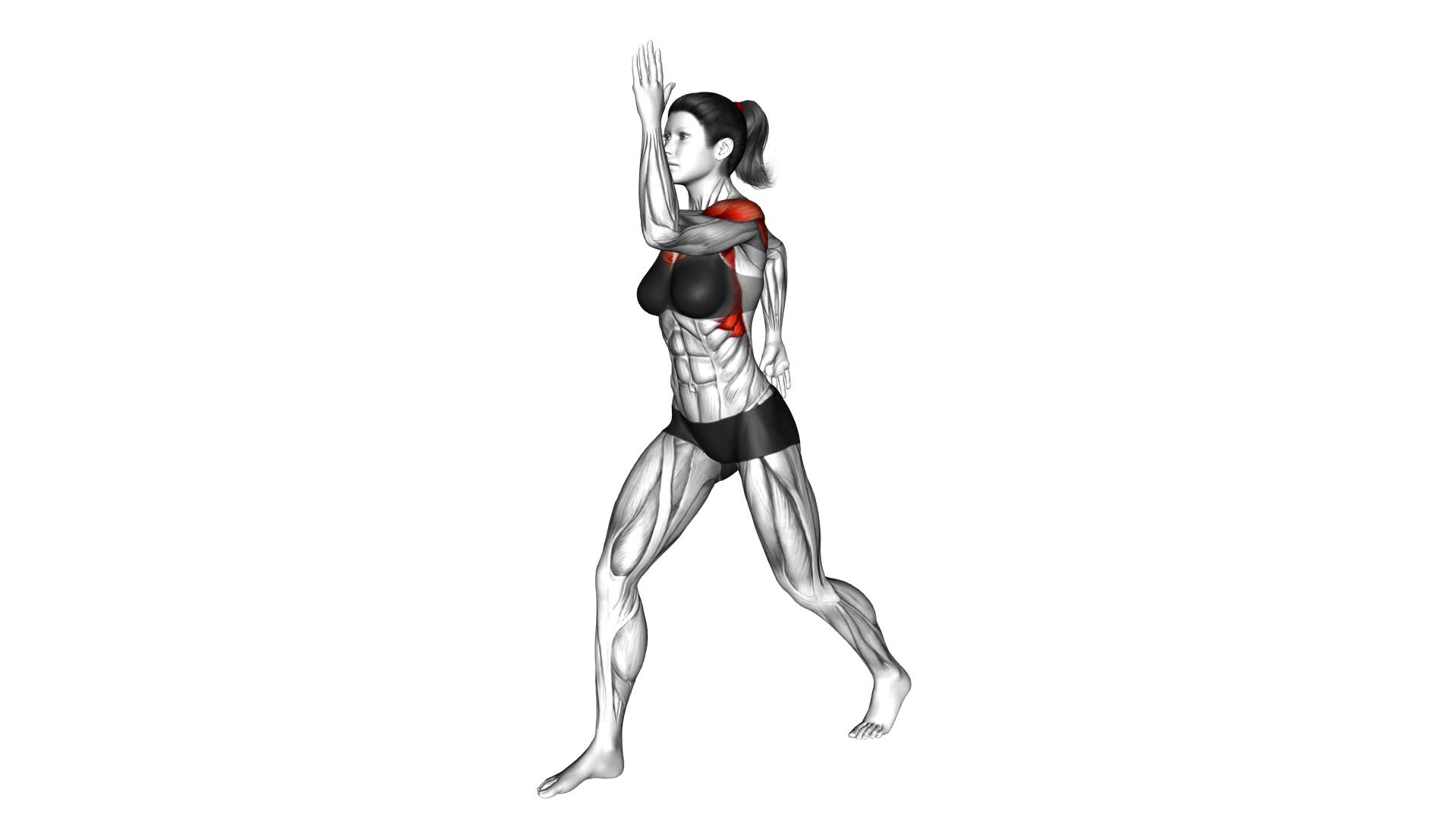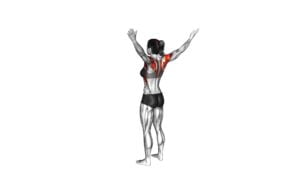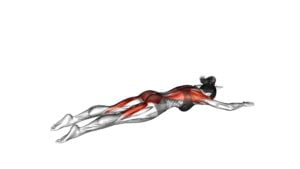Quickly Swing Arms in Place (Female) – Video Exercise Guide & Tips

Looking to tone your arms quickly? Check out this video exercise guide and tips for swinging your arms in place.
Watch This Exercise Video
In just a few minutes a day, you can improve your arm strength and definition. Learn the proper form and technique, target the right muscles, and avoid common mistakes.
Whether you're a beginner or advanced, there are variations and modifications for every fitness level.
Get ready to incorporate arm swinging into your workout routine and see the results!
Key Takeaways
- Swinging arms in place can improve cardiovascular fitness and reduce the risk of heart disease.
- Proper form and technique, such as maintaining a relaxed posture and avoiding common form mistakes, are important for maximizing the benefits and preventing strain or injury.
- Swinging arms in place can target and improve the muscles in the shoulders, upper back, and arms, leading to improved shoulder mobility, upper body strength, and a cardiovascular workout.
- The exercise can be modified for different fitness levels, from beginners starting with small arm swings to advanced individuals using heavier weights or resistance bands. Injured or individuals with limited mobility can also modify the exercise with seated arm swings or lower range of motion, after consulting a healthcare professional.
Benefits of Swinging Arms in Place
Swinging your arms in place provides numerous benefits for your overall fitness and coordination. Incorporating arm swinging exercises into your daily routine can have a positive impact on your health.
One of the key health benefits of arm swinging exercises is improved cardiovascular fitness. When you swing your arms vigorously, you increase your heart rate, which helps strengthen your heart and improve its efficiency. This can lead to a reduced risk of heart disease and other cardiovascular conditions.
In addition to cardiovascular benefits, arm swinging also helps to improve coordination and balance. As you swing your arms, you engage the muscles in your upper body, including your shoulders, arms, and chest. This helps to improve muscle tone and strength, leading to better overall coordination and balance.
To effectively incorporate arm swinging into your daily routine, you can start by setting aside a few minutes each day for this exercise. Stand with your feet shoulder-width apart, relax your shoulders, and begin swinging your arms back and forth in a controlled manner. You can gradually increase the speed and intensity as you become more comfortable.
Remember to maintain proper form and avoid any jerky or excessive movements. Start slowly and gradually increase the duration and intensity of your arm swinging exercises over time.
Proper Form and Technique for Swinging Arms
To ensure you get the most out of your arm swings, it's important to understand the proper form and technique.
By maintaining a relaxed posture and engaging your core, you can maximize the benefits of this exercise.
Avoid common form mistakes such as hunching your shoulders or swinging your arms too forcefully, as this can lead to strain or injury.
Arm Swing Benefits
You should regularly incorporate arm swings into your exercise routine to maximize the benefits of proper form and technique.
Arm swing variations can provide a variety of benefits, including improved cardiovascular endurance. By swinging your arms in sync with your steps during activities like walking or running, you engage your upper body muscles, increasing your overall calorie burn and enhancing the efficiency of your workout.
This movement also helps to maintain balance and stability, especially when navigating uneven terrain. Additionally, arm swings can improve your posture by promoting proper alignment of your shoulders and spine.
Common Form Mistakes
To avoid common form mistakes while swinging your arms, focus on maintaining proper form and technique. Here are some tips to help you improve your posture and increase your upper body strength:
- Keep your shoulders relaxed and down, avoiding any tension or shrugging.
- Engage your core muscles to provide stability and support during the arm swing.
- Maintain a slight bend in your elbows to prevent hyperextension and reduce stress on the joints.
- Swing your arms in a controlled and fluid motion, avoiding any jerky movements or excessive swinging.
By following these guidelines, you can ensure that you're getting the most out of your arm swing exercise, while also promoting proper posture and strengthening your upper body muscles.
Remember to start slowly and gradually increase the intensity as you become more comfortable with the movement.
Targeted Muscles During Arm Swinging Exercise
During arm swinging exercise, your muscles are engaged and working to propel your arms forward and backward. This exercise primarily targets the muscles in your shoulders, upper back, and arms. The swinging motion activates your deltoids, which are responsible for raising and lowering your arms. Additionally, your trapezius muscles, located in your upper back, are engaged to stabilize and control the movement of your arms. The muscles in your arms, such as the biceps and triceps, also play a role in generating force during the swinging motion.
Engaging these muscles through arm swinging exercise offers several benefits. Firstly, it helps to improve shoulder mobility and flexibility. The repetitive swinging motion helps to increase the range of motion in your shoulder joints, promoting better mobility and reducing the risk of injury.
Secondly, this exercise can contribute to upper body strength development. The muscles targeted during arm swinging exercise are involved in many everyday activities, such as lifting objects and pushing doors. By strengthening these muscles, you can enhance your overall upper body strength and functional fitness.
Lastly, arm swinging exercise can also be a great cardiovascular workout, as it increases your heart rate and helps burn calories. Incorporating arm swinging exercise into your fitness routine can be an effective way to engage multiple muscle groups and improve your overall physical health.
Variations and Modifications for Different Fitness Levels
Are you looking to adapt the arm swinging exercise to your specific fitness level? Good news! There are variations and modifications available that can cater to different levels of fitness.
Whether you're a beginner or an advanced athlete, you can adjust the intensity of the arm swinging exercise to suit your needs and goals. These options allow you to challenge yourself while still maintaining proper form and preventing injury.
Fitness Level Adaptations
Adjust the intensity of the arm swinging exercise based on your fitness level.
Here are some fitness level modifications, progressions, and regressions to help you adapt the exercise to your needs:
- Beginner: Start with small arm swings and focus on maintaining proper form. Gradually increase the range of motion as you feel more comfortable and confident.
- Intermediate: Increase the speed and intensity of your arm swings while maintaining control. You can also add light weights or resistance bands to make the exercise more challenging.
- Advanced: Perform the arm swings at a faster pace with maximum effort. You can use heavier weights or resistance bands to further increase the intensity.
- Injured or Limited Mobility: Modify the exercise by performing seated arm swings or using a lower range of motion. Consult with a healthcare professional for personalized modifications.
By adjusting the intensity of the arm swinging exercise to match your fitness level, you can progress gradually and challenge yourself appropriately.
Now, let's explore varied intensity options for this exercise.
Varied Intensity Options
To vary the intensity of the arm swinging exercise and cater to different fitness levels, you can explore a range of variations and modifications.
For individuals looking for a higher intensity workout, you can increase the speed and range of motion of the arm swings. This will engage more muscles and elevate your heart rate.
On the other hand, if you're just starting out or have limited mobility, you can perform smaller and slower arm swings. This will still provide a beneficial workout while reducing the strain on your joints.
Additionally, you can add equipment options such as dumbbells or resistance bands to increase the resistance and challenge your muscles further.
By adjusting the intensity levels and incorporating equipment options, you can customize the arm swinging exercise to suit your fitness level and goals.
Now, let's move on to the next section and learn about common mistakes to avoid during arm swinging.
Common Mistakes to Avoid During Arm Swinging
Make sure you keep your elbows relaxed and avoid tensing up during arm swinging. This is important to ensure that you're performing the exercise correctly and effectively.
Here are some common mistakes to avoid during arm swinging:
- Gripping too tightly: Holding onto hand weights or resistance bands with a tight grip can lead to unnecessary tension in your arms and shoulders. Relax your grip to allow for a more fluid movement.
- Swinging too forcefully: While it may be tempting to swing your arms with maximum force, it can put strain on your joints and lead to injuries. Focus on controlled and smooth movements, rather than forceful swings.
- Lifting your shoulders: It's common to lift your shoulders when performing arm swinging exercises, especially when using weights. However, this can cause tension and strain in your neck and shoulders. Keep your shoulders relaxed and down throughout the exercise.
- Neglecting proper posture: Maintaining good posture is key during arm swinging exercises. Avoid slouching or leaning forward, as this can compromise the effectiveness of the exercise and increase the risk of injury. Stand tall with your core engaged and your shoulders back.
Tips for Incorporating Arm Swinging Into Your Workout Routine
To maximize the benefits of arm swinging exercises, incorporate them seamlessly into your workout routine by gradually increasing the intensity and duration of the swings. Arm swinging can be a great addition to your cardio workouts, as it engages multiple muscle groups and increases your heart rate. This can help you burn more calories and promote weight loss.
One way to incorporate arm swinging into your cardio routine is by starting with a brisk walk or jog and gradually adding in arm swings. Begin by swinging your arms gently back and forth, keeping them relaxed and parallel to the ground. As you feel more comfortable, increase the intensity by swinging your arms with more force and extending them out further.
Another option is to incorporate arm swings into exercises such as jumping jacks or high knees. During these exercises, focus on swinging your arms vigorously in sync with your movements. This won't only provide an extra challenge for your upper body, but also increase the overall intensity of the exercise.
Remember to listen to your body and gradually increase the duration and intensity of your arm swinging exercises. Start with shorter intervals and gradually work your way up to longer sessions. By incorporating arm swinging into your cardio routine, you can maximize your workout and achieve your weight loss goals more effectively.
Frequently Asked Questions
How Many Repetitions of Arm Swinging Should I Do?
To get the most out of arm swinging exercises, it's important to do the right number of repetitions.
The benefits of arm swinging exercises include improved shoulder mobility and increased upper body strength.
When it comes to the proper form for arm swinging exercises, it's crucial to maintain a straight back, engage your core, and keep your arms relaxed.
As for how many repetitions you should do, it's best to start with 10-15 and gradually increase as you get stronger.
Can Arm Swinging Exercise Help in Weight Loss?
Arm swinging exercise involves quickly swinging your arms in place. It's a simple yet effective technique that can aid in weight loss. By engaging your arm muscles, this exercise helps to burn calories and increase your overall calorie expenditure.
Additionally, arm swinging can improve your cardiovascular endurance and enhance upper body strength. Incorporating this exercise into your fitness routine can provide numerous benefits for weight loss and overall fitness.
Is It Necessary to Warm up Before Doing Arm Swinging Exercise?
It's important to warm up before doing any exercise, including arm swinging. Warming up helps increase blood flow to your muscles, making them more flexible and less prone to injury.
Arm swinging exercise has numerous benefits for overall fitness, such as improving cardiovascular health, strengthening arm and shoulder muscles, and increasing range of motion.
To maximize results, you can try different variations of arm swinging exercises, such as adding weights or incorporating different arm movements.
Can Arm Swinging Exercise Be Done With Weights?
Yes, you can incorporate arm swinging variations with weights into your exercise routine. Adding weights to arm swinging exercises can provide additional resistance, helping to increase muscle strength and endurance.
It can also enhance the benefits of the exercise by engaging more muscles in your arms, shoulders, and upper body. Remember to start with lighter weights and gradually increase as your strength improves.
Consult a fitness professional for proper form and guidance.
Can Arm Swinging Exercise Be Done by People With Shoulder Injuries?
Yes, arm swinging exercise can be modified for people with shoulder injuries. There are alternative arm movements that can be done to avoid putting strain on the injured shoulder. These modifications allow you to still benefit from the cardiovascular advantages of arm swinging.
It's important to consult with a healthcare professional or physical therapist to ensure you're performing the exercise correctly and safely. Arm swinging can improve your cardiovascular health by increasing your heart rate and promoting blood circulation.
Conclusion
Incorporating arm swinging into your workout routine can provide numerous benefits. These include improved cardiovascular health, increased upper body strength, and enhanced coordination. By following proper form and technique, you can effectively target the muscles in your arms, shoulders, and chest.
Remember to avoid common mistakes such as overextending your arms or swinging too forcefully. Whether you're a beginner or advanced fitness enthusiast, there are variations and modifications available to suit your fitness level.
Start swinging your arms and reap the benefits today!

Author
Years ago, the spark of my life’s passion ignited in my mind the moment I stepped into the local gym for the first time. The inaugural bead of perspiration, the initial endeavor, the very first surge of endorphins, and a sense of pride that washed over me post-workout marked the beginning of my deep-seated interest in strength sports, fitness, and sports nutrition. This very curiosity blossomed rapidly into a profound fascination, propelling me to earn a Master’s degree in Physical Education from the Academy of Physical Education in Krakow, followed by a Sports Manager diploma from the Jagiellonian University. My journey of growth led me to gain more specialized qualifications, such as being a certified personal trainer with a focus on sports dietetics, a lifeguard, and an instructor for wellness and corrective gymnastics. Theoretical knowledge paired seamlessly with practical experience, reinforcing my belief that the transformation of individuals under my guidance was also a reflection of my personal growth. This belief holds true even today. Each day, I strive to push the boundaries and explore new realms. These realms gently elevate me to greater heights. The unique combination of passion for my field and the continuous quest for growth fuels my drive to break new ground.







